Cite this document
(MR Spectroscopy Report Example | Topics and Well Written Essays - 4250 words, n.d.)
MR Spectroscopy Report Example | Topics and Well Written Essays - 4250 words. https://studentshare.org/physics/1819045-mr-spectroscopy
MR Spectroscopy Report Example | Topics and Well Written Essays - 4250 words. https://studentshare.org/physics/1819045-mr-spectroscopy
(MR Spectroscopy Report Example | Topics and Well Written Essays - 4250 Words)
MR Spectroscopy Report Example | Topics and Well Written Essays - 4250 Words. https://studentshare.org/physics/1819045-mr-spectroscopy.
MR Spectroscopy Report Example | Topics and Well Written Essays - 4250 Words. https://studentshare.org/physics/1819045-mr-spectroscopy.
“MR Spectroscopy Report Example | Topics and Well Written Essays - 4250 Words”. https://studentshare.org/physics/1819045-mr-spectroscopy.


